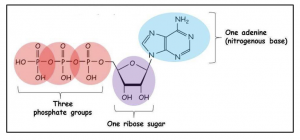The Structure of ATP (A-level Biology)
The Structure of ATP
Respiration and ATP
The Need for Energy
Respiration is the process by which all cells synthesise ATP in order to meet the energy requirements of various life processes.
In this chapter, we will discuss the mechanism by which glucose is metabolised (broken down) for ATP production. Before we move on, we will do a brief overview of the two types of respiration: anaerobic and aerobic respiration.
Energy is needed for several processes in the body, including:
- Active transport
- Exocytosis
- Endocytosis
- Anabolism
- Cell division
- Movement
ATP is an Immediate Energy Source
- The body cannot directly get its energy from glucose. Glucose is not a direct energy source. Instead, the body uses the energy released from breaking down glucose, to drive phosphorylation of ADP. This makes ATP, which is an immediate energy source that cells can use quickly.
- ATP contains three phosphate groups. As we have seen previously, ATP consists of three phosphate groups, one nitrogenous base and one ribose sugar.

Fig X: The structure of ATP. Image is free to use, share and modify. Taken from https://loretocollegebiology.weebly.com/atp-structure–function.html





Still got a question? Leave a comment
Leave a comment